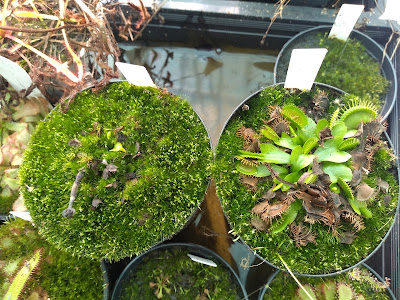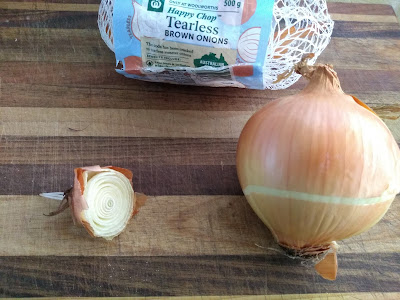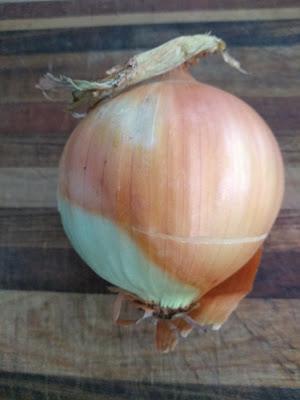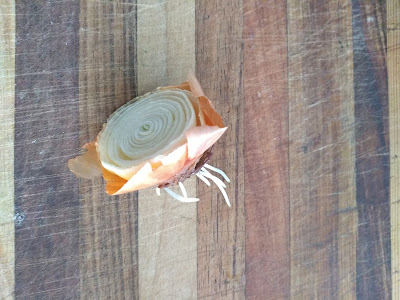I wrote a previous blog post comparing different Venus flytrap clones. I did my best to provide the best comparison that I could by using similar age plants grown side by side under the same conditions for one year.
In that post I compared several different Venus flytrap varieties to 'Wally' as this is my standard as it is a very vigorous clone that I had a number of plants at various ages and sizes.
At that time I also had a new DCXL Venus fly trap, but it was a poor comparison because the plants were not grown under the same conditions as anything else I had.
I have decided to do a better comparison of these two varieties as they are both vigorous an excellent choices for new carnivorous plant growers. One is low growing, the other gets tall leaves, they both get decent colouration, and both are pretty forgiving of less than ideal conditions.
I took flower stalk cuttings of 'DCXL' and 'Wally' late in the year 2021, and grew them over winter side by side in the same pot. After winter I repotted them on the same day into the same sized pots, in the same growth media. I grew them in separate pots, side by side, in the same tray of water. This is a good comparison as everything other than their genetics was exactly the same.
Similar sized flower stalk cuttings were taken from both plants late 2021. The flower stalk cuttings were planted into live sphagnum moss on the same day and kept in the same pot to grow a little. The plantlets survived a very mild winter, and were repotted into damp sphagnum peatmoss mixed with sand on 11 September 2022. Being in Australia, September is the start of Spring.
The photos below show comparison of growth between the two clones. I tried to take photos in the first week of each month to demonstrate the speed at which they were growing.
Early September 2022 (September is the start of spring in Australia)
It is a little difficult to see in the photo below, but the two sets of tiny Venus flytrap plants are already very different to each other. Below is a comparison photo, and a closer photo of each.
 |
| Comparison: Wally vft on left, DCXL vft on right |
Wally produced a lot more plants from the flower stalk cutting than DCXL did. Each Wally plant has less leaves than DCXL, and at this stage has slightly smaller traps. At this small stage the Wally flytraps look quite delicate. While I was tempted to divide the little Wally flytraps I decided that the comparison would be better if I left them to grow as they were.
 |
| Wally clones from flower stalk cutting |
DCXL flower stalk cutting produced fewer plants, but each has more leaves per plant and slightly larger traps at this stage. At this tiny stage the DCXL flytraps appear small but robust. At this point in time DCXL has more colour in the traps than Wally.
 |
| DCXL clones from flower stalk cutting |
From here they grew in these separate identical pots, side by side, in the same tray of water, and I tried to take a photo of them in the first week of each month.
Early October 2022
The traps of DCXL vft are now noticeably larger than those of Wally vft. Wally is gaining more colour on all parts of the plant. The leaves of DCXL are not yet what I would consider to be upright growth, but it is less prostrate that Wally.
I only took one photo in October as they had not done anything too incredible since the previous month.
 |
| Venus Flytrap Wally and DCXL vft - October 2022 |
Early November 2022
While plants in both pots are still very small, DCXL now has considerably larger traps than Wally. DCXL is also starting to put out some upright growth, while Wally is staying close to the ground. Wally has more colour on pretty much every part of the plant, but both plants are colouring up quite nicely.
You can't tell by the photos, but there are a lot more Wally plants than DCXL plants in these pots. Each DCXL plant is larger so from a distance it looks like there are more of them. The DCXL plants are big beefy plants with many leaves and large traps.
It's clear even at this small size that both of these flytrap clones are very impressive varieties! If I were only to grow two varieties of Venus flytrap then these two would probably be it.
 |
| DCXL Venus flytrap - November 2022 |
 |
| Wally Venus flytrap - November 2022 |
 |
| Wally and DCXL growing side by side |
 |
| Wally Venus fly trap |
 |
| DCXL Venus fly trap |
 |
| Wally on left, DCXL on right |
Now that these Venus flytraps are out of dormancy and actively growing they should really take off. I can hardly wait to see what they do over the next month.
Early December 2022 (December is the start of Summer in Australia)
The weather has been strange, and most of my venus flytraps are either not coming out of dormancy, or are growing flower stalks and non carnivorous leaves. Some of my other varieties of venus flytraps are declining and some of the weak varieties look like they may die this year.
These two little ones are not going as well as I would have expected, and Wally appears to be struggling a little. They are still growing side by side, in the same tray of water, and conditions as as close to identical as I could make them.
Wally is getting a lot more colour, and is staying low to the ground as always. DCXL is growing into an impressive looking plant with some nice upright growth, decent colouration of trap interior, and some decent trap sizes for such a young plant.
 |
| Wally and DCXL comparison |
 |
| DCXL vft December 2022 |
 |
| Wally vft December 2022 |
 |
| DCXL Venus flytrap |
 |
| Wally Venus flytrap |
Early January 2023
The weather has been all over the place. A lot of my little plants have been suffering and burning off. Some of my typical venus flytraps have died.
Wally continues to push through, and DCXL continues to grow larger. Clearly these are both excellent varieties for new growers.
 |
| Wally on the left, DCXL on the right |
 |
| DCXL |
 |
| Wally |
 |
| DCXL Venus Flytrap |
 |
| Wally and DCXL Venus Flytrap comparison |
 |
| Wally Venus Flytrap |
Early February 2023
After six months these have not grown as much as I would have expected. That being said, they are both larger and healthier than many of my other Venus Flytrap cultivars.
DCXL has far larger traps, and longer leaves, than Wally. Both plants have decent colouration.
Some of the smaller Wally plants appear to have died off, while it appears all of the DCXL plants are still alive.
The weather has been all over the place here. One day will be sunny, hot, and 35C, the next cold, windy, and 19C. As well as the temperature fluctuating rather dramatically form day to day, it has been really dry here for the past few months. This isn't a huge issue as I grow these in a tray of water. I was watering using bore water for some time and there was some salt build up as we didn't have any rain to flush it away, I am back to using rain water and they are looking better.
I think my little plants are getting ready for dormancy as DCXL has stopped producing any upright growth.
 |
| DCXL flytrap |
 |
| Wally flytrap |
 |
| Wally on left, DCXL on right |
 |
| DCXL VFT February |
 |
| Wally VFT February |
Early March 2023 (March is the start of Autumn in Australia)
No more upright growth. Both of these pots would have grown better had I divided them instead of leaving them together.
We had very strange weather this year so lots of plants are already entering dormancy. Things will probably look run down from here until Spring.
 |
| Wally |
 |
| DCXL |
 |
| Wally plants from flower stalk cutting |
 |
| DCXL plants from flower stalk cutting |
 |
| Wally on left, DXCL on right |
 |
| The difference between these clones is incredible |
Early May 2023
Winter is just around the corner, so dormancy isn't too far off. Neither clone looks great while dormant, but that is ok. Moss is growing more than I would like, but I won't try to do anything about that until closer to Spring.
 |
| Wally VFT going into winter |
 |
| DCXL VFT going into winter |
Early June 2023 (June is the start of winter in Australia)
 |
| Venus Flytrap Comparison - Wally and DCXL |
 |
| Wally VFT start of winter |
 |
| DCXL VFT start of winter |
Early July 2023
Being winter, all of my Venus flytraps look dreadful as they are mostly dormant. Other than the moss, everything is as it should be. I plan to repot these late winter/early spring and when I do I will remove as much moss as possible.
Early August 2023
As you can see, the plants are dormant and look horrible. This is normal and healthy for Venus Flytraps over winter here. Spring is around the corner, once the weather warms and there is more sunlight I expect these plants to grow and look good once again.
 |
| Dormant VFTs, Wally on left, DCXL on right |
 |
| Wally VFT late winter |
 |
| DCXL VFT late winter |
 |
| Wally and DCXL flytraps over winter |
12 month Comparison
Here they are repotted, and ready for spring growth. Side by side, Wally VFT on the left and DCXL vft on the right. Below is the initial phot, as well as photos of where they are now.
Ideally I would have divided them a year ago, but I wanted to show what they would do if left as is.
 |
| September 2022: Wally vft on left, DCXL vft on right |
 |
| August 2023: Wally vft on left, some of the DCXL vft on right |
 |
| August 2023 |
From the Wally flower stalk cutting I ended up with four healthy plants and a couple of tiny ones that could be divided once they start growing in warmer weather. Four of them should be flowering size perhaps this year but probably next year. This past year the growing conditions were not good, and the crowding only made things worse and many of the smallest plants died. Had I divided these earlier I would have ended up with many more plants.
From the DCXL flower stalk cutting I ended up with six healthy plants. Each should reach flowering size this year or at the latest next year. Even though the weather was not great the past year, they did not suffer as much from crowding as they started with less plantlets.
This past year the weather was not ideal for flytraps. Both of these varieties fared much better than any of the other varieties, named or unnamed, that I am growing.
 |
| Venus Flytraps: Wally on left, DCXL on the right |
 |
| DCXL flyraps ready for spring |
 |
| Wally flytraps ready for spring growth |
 |
| DCXL Venus Flytraps largely dormant |
While venus flytraps are all the same species, there are many different varieties, each of which grows differently, looks different, and performs best under slightly different conditions. Wally stays low to the ground and divides well, and gets a lot more colouration with more light intensity. DCXL has tall summer growth, large summer traps, and produce big beefy plants. Both varieties produce decent sized traps. Both varieties are great for beginners as they are forgiving of difficult growing conditions.
From here these plants will break dormancy, and put on some active growth. I will probably leave some as they are, and I may attempt to divide others.
When they send up flower stalks I will probably try to take more cuttings. I may allow them to flower and attempt to gather seed from them, but I tend to have low success having flytraps produce viable seed. Growing Venus Flytraps from see is fun as every seed grown plant is unique, it also takes years to get a decent sized plant.






































